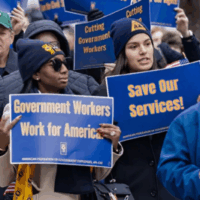As tens of millions of workers—more than one-fifth of the U.S. workforce—were losing their jobs at the start of the pandemic, worker advocates sounded another important alarm: In many states, being laid off would not release workers from “non-compete” agreements they had signed with their employers, which would restrict what future job offers they could accept.
The prospect that employers could hamper workers in their return to work by using non-competes seemed like a far-off possibility in March 2020. But now, with many seeking to return to work, the possibility of workers being bound by past non-compete agreements or agreeing to new ones is deeply concerning. Non-competes limit workers’ power and autonomy and exacerbate existing inequities that disproportionately harm workers of color.
What Are Non-Competes?
Non-competes are contracts, signed by employees when they accept a job, that restrict them from taking a job in the same industry for a set period of time after they leave their position. Restrictions may be defined by industry or geography, and some may list specific rival competitor companies that employees are prohibited from joining. Research suggests that nearly one in five U.S. workers is currently bound by a non-compete.[1] The types of workers bound range from chief executive officers to security guards to sandwich makers, as in the infamous Jimmy John’s case that first brought this issue to the fore.[2]
Nearly one in five U.S. workers—from CEOs to security guards to sandwich makers—is currently bound by a non-compete.
Employers usually present non-compete provisions in a “take it or leave it” fashion. They may require workers to sit out of the labor market for a year or even longer. Not surprisingly, non-competes have been shown to depress wages by reducing competition.[3] This is what economists refer to as the problem of monopsony, where employers have greater market power and are able to continue to offer lower wages due to lack of competition.[4] A recent study showed that a 2008 Oregon ban on non-compete agreements for hourly workers increased hourly wages by 2 to 3 percent on average.[5] Studies also showed that non-competes may exacerbate the wage gap that workers of color face, because these workers are more likely to be subject to strict enforcement of non-competes and thus to be unable to move to better paying positions.[6]
Non-competes may exacerbate the wage gap that workers of color face.
Push for State Reforms
Many legislatures are successfully taking on the challenge of non-compete reform. New laws have been passed or are advancing in several states. Bills were introduced in West Virginia, Minnesota, Connecticut, Colorado, New York, and Iowa.[7] In New York, Governor Kathy Hochul included a non-compete provision in her budget proposal, and the State Senate also introduced a bill.[8] Both the West Virginia and Iowa bills proposed banning non-competes for workers in low-wage industries.[9]
Many legislatures are successfully taking on the challenge of non-compete reform.
The Minnesota non-compete proposal would limit agreements to an annual salary equal to the median family income and also provide for “garden leave”, i.e., an employer would have to pay 50 percent of the employee’s highest annual base salary during the restricted period.[10] Connecticut’s bill, had it passed, would have set the non-compete threshold close to $100k.[11] Colorado’s bill would be an important improvement of the state’s previous non-compete law.[12] Although many legislative sessions ended without passing the non-compete laws under consideration, the bills in New Jersey, New York, and Colorado are still being considered.[13]
The 2021 state legislative sessions saw numerous states adopt non-compete reforms. Illinois updated its non-compete law to ban non-competes for all workers making $75k a year or less (a threshold that will go up every year to match inflation).[14] Oregon lawmakers amended the state’s non-compete law to increase the salary threshold for enforcement of non-compete agreements to $100,533.[15] Nevada also officially banned non-competes for hourly workers.[16] Indeed, more and more states have taken up non-compete reform since 2014, when it was revealed that Jimmy John’s was using non-competes in its sandwich shops.[17]
Movement Nationally
President Biden’s initiative to improve competition through his Executive Order on Competition, released on July 9, 2021, has also helped fuel the push for these bills.[18] As a result of this directive, federal agency work in the area has increased.
On March 7th, the Treasury Department, in partnership with the Labor Department, the Justice Department, and the Federal Trade Commission (FTC), released a report on “The State of Labor Market Competition.” The report found that the lack of competition results in wage declines of between 15 and 25 percent.[19] It also highlighted the power differential that exists between companies and workers, based on information asymmetry as well as labor market forces, that leads to employers exerting market power and offering lower wages and worse working conditions.[20] Now that the FTC has a full complement of commissioners, advocates are pushing for the agency to pursue rulemaking in this area. The Open Markets Institute initially submitted a petition to the FTC in 2019, joined by 60 signatory organizations, including NELP.[21]
The report also highlighted how many of the coercive waivers (such as non-disclosures, arbitration agreements, and non-competes) work together to reduce worker power—a perspective I discussed in a 2018 blog post on non-compete provisions in context and also in an article for the Regulatory Review in 2019.[22] Alongside the Biden executive order, the Uniform Law Commission released a Uniform Restrictive Employment Agreement Act, a uniform model state law with a number of possible regulations that could be easily adopted.[23] Notably, several Republican legislatures have considered adopting these regulations to reduce the impact of non-competes on workers in their states.[24]
Coercive waivers, such as non-disclosures, arbitration agreements, and non-competes, work together to reduce worker power.
Where We Go From Here
In the wake of the “Great Resignation,” management-side lawyers have become even more aggressive in their tactics to keep employees bound by these coercive agreements. In a recent blog post on a human resources site, management-side lawyers stated that they have seen an uptick in employers wanting to sue employees because of the talent shortage; they not only want to retain the employees but also prevent them from going elsewhere.[25] Such articles highlight the abusive way in which non-compete agreements are used to block workers from going elsewhere to use their talents and skills.
In the wake of the “Great Resignation,” management-side lawyers have become more aggressive in their tactics to keep employees bound by coercive agreements.
State law advocacy will hopefully help level the playing field for workers seeking to be free from onerous non-compete agreements imposed by their employers, but advocates still have more to do. While many states are moving in the right direction, federal legislative reform and rulemaking are still crucial, especially for workers in states that have no intention of freeing workers from these coercive agreements.
While many states are moving in the right direction, federal legislative reform and rulemaking remain crucial.
The Workforce Mobility Act, sponsored by Senators Chris Murphy (D-CT) and Todd Young (R-IN), would eliminate non-competes for the majority of workers, keeping them only for workers involved in the sale of a business. This bipartisan bill would go a long way toward ensuring that workers can chart their own careers; it would take power away from employers that abuse the use of non-competes. A federal bill that bans non-competes for workers could, like Oregon’s non-compete law, have a positive impact on the wages of hourly workers. Now is the time to continue to push for broad non-compete reform, creating the just recovery that workers need.
LEARN MORE: FAQ ON NON-COMPETES
[1] Evan Starr, J.J Prescott, and Norman Bishara, Noncompetes in the U.S. Labor Force (December 24, 2017), https://ssrn.com/abstract=2625714.
[2] Dave Jamieson, Jimmy John’s Makes Low-wage workers sign oppressive non-compete agreements, Huffington Post, Oct. 13, 2014, https://www.huffpost.com/entry/jimmy-johns-non-compete_n_5978180?1413230622=; Sophie Quinton, These days, even janitors are being required to sign non-compete clauses, USA Today, May 27, 2017, https://www.usatoday.com/story/money/2017/05/27/noncompete-clauses-jobs-workplace/348384001/, Najah Farley, Non-compete provisions in Context, National Employment Law Project Blog, Sept. 27. 2018, https://www.nelp.org/blog/non-compete-provisions-context-nelp-supports-calls-reform/
[3] Marshall Steinbaum, How widespread is Labor Monopsony? Some New Results Suggest its Pervasive, ROOSEVELT INSTITUTE, December 18, 2017; Greg Robb, Wage growth is soft due to declining worker bargaining power, former Obama economist says, MARKETWATCH, August 24, 2018.
[4] Id.; Greg Robb, Wage growth is soft due to declining worker bargaining power, former Obama economist says, MARKETWATCH, August 24, 2018.
[5] Michael Lipsitz and Evan Starr, Low-Wage Workers and the Enforceability of Noncompete Agreements, Management Science, April 5, 2021, https://pubsonline.informs.org/doi/10.1287/mnsc.2020.3918
[6] Matthew S. Johnson, Kurt Lavetti, Michael Lipsitz, The Labor Market Effects of Legal Restrictions on Worker Mobility, February 17, 2021, https://papers.ssrn.com/sol3/papers.cfm?abstract_id=3455381; see also, Mark Stelzner and Kate Bahn, Discrimination and Monopsony Power, Washington Center for Equitable Growth, July 13, 2020, https://equitablegrowth.org/working-papers/discrimination-and-monopsony-power/.
[7] Chris Marr, Red State Lawmakers Look at Noncompete Bans for Low-Wage Workers, Bloomberg Law Daily Labor Report, Feb. 9, 2022, https://news.bloomberglaw.com/daily-labor-report/red-state-lawmakers-look-at-noncompete-bans-for-low-wage-workers.
[8] N.Y. Legis. Senate S-6425. Reg. Sess. 2021-2022, Prohibits non-compete agreements and certain restrictive covenants, https://www.nysenate.gov/legislation/bills/2021/s6425.
[9] West Virginia Legislature, 2022 Regular Session, Senate Bill 453, https://aboutblaw.com/1uU; The General Assembly of the State of Iowa, Senate File 496, https://aboutblaw.com/1zd
[10] Brian Hall, House panel approves bill to limit use of employee non-compete clauses, Minnesota Legislature, Feb. 22, 2022, https://www.house.leg.state.mn.us/SessionDaily/Story/17140.
[11] Connecticut General Assembly Bill No. 5249, February Session, 2022, An Act Concerning Noncompete Agreements, https://cga.ct.gov/2022/TOB/H/PDF/2022HB-05249-R00-HB.PDF
[12] Colorado General Assembly, HB22-1317, 2022 Regular Session, Restrictive Employment Agreements, https://leg.colorado.gov/bills/hb22-1317.
[13] New Jersey Legislature, Assembly, No. 3715, Bill A3715, Session 2022-2023, https://www.njleg.state.nj.us/bill-search/2022/A3715/bill-text?f=A4000&n=3715_I1; N.Y. Legis. Senate S-6425. Reg. Sess. 2021-2022, Prohibits non-compete agreements and certain restrictive covenants, https://www.nysenate.gov/legislation/bills/2021/s6425; Colorado General Assembly, HB22-1317, 2022 Regular Session, Restrictive Employment Agreements, https://leg.colorado.gov/bills/hb22-1317; see, Jessica Folker, Bill to Limit Noncompete Agreements Passes House, LawWeek Colorado, April 19, 2022, https://www.lawweekcolorado.com/article/bill-to-limit-noncompete-agreements-passes-house/
[14] Illinois Freedom to Work Act, 820 ILCS 90/10 (2017)
[15] ORS 653.925, https://oregon.public.law/statutes/ors_653.295
[16] Nevada Assembly Bill 47, 2021, 81st Legis., https://legiscan.com/NV/bill/AB47/2021
[17] Dave Jamieson, Jimmy John’s Makes Low-wage workers sign oppressive non-compete agreements, Huffington Post, Oct. 13, 2014, https://www.huffpost.com/entry/jimmy-johns-non-compete_n_5978180?1413230622=.
[18] White House, Fact Sheet: Executive Order on Promoting Competition in the American Economy (July 9, 2021), https://www.whitehouse.gov/briefing-room/statements-releases/2021/07/09/fact-sheet-executive-order-on-promoting-competition-in-the-american-economy/.
[19] U.S. Department of the Treasury, The State of Labor Market Competition, March March 7, 2022, https://home.treasury.gov/system/files/136/State-of-Labor-Market-Competition-2022.pdf
[20] Id.
[21] Open Markets Institute Petition to the Federal Trade Commission for Rulemaking to Prohibit Worker Non-Compete Clauses, March 20, 2019, https://www.openmarketsinstitute.org/publications/petition-3-20-2019
[22] Najah Farley, Non-Compete Provisions in Context: Why NELP Supports Calls For Reform, National Employment Law Project (Sept. 27, 2018), https://www.nelp.org/blog/non-compete-provisions-context-nelp-supports-calls-reform/.
[23] Katie Robinson, Uniform Law Commission Approves Uniform Restrictive Employment Agreement Act, July 23, 2021, https://www.uniformlaws.org/committees/community-home/digestviewer/viewthread?MessageKey=ef54eaf7-88d8-4bba-8597-7bb794f99867&CommunityKey=d4b8f588-4c2f-4db1-90e9-48b1184ca39a&tab=digestviewer
[24] Chris Marr, Red State Lawmakers Look at Noncompete Bans for Low-Wage Workers, Bloomberg Law Daily Labor Report, Feb. 9, 2022, https://news.bloomberglaw.com/daily-labor-report/red-state-lawmakers-look-at-noncompete-bans-for-low-wage-workers.
[25] Jessica Mach, Labor Shortages sparks rise in non-compete lawsuits by employers, Benefits Pro, May 10, 2022, https://www.benefitspro.com/2022/05/10/labor-of-law-amid-labor-shortages-more-employers-suing-to-enforce-non-competes-412-129910/?slreturn=20220413142334. “A lot of employees have decided to leave their posts. They’re looking for new opportunities, and at the same time, their current employers—because of a talent shortage—are really hoping to retain those employees or at least prevent them from going somewhere else,” said Jeanne Fugate, a partner at the Los Angeles and San Francisco offices of King & Spalding.
Related to
The Latest News
All newsMayor Bowser & D.C. Council Must Respect the Will of D.C. Voters by Rejecting Repeal of Initiative 82

Blog
New Brief Sheds Light on the Amazon’s Dangerous ‘Flex’ Labor Model

News Release
NELP Denounces Supreme Court Ruling Permitting Immediate Layoffs of Hundreds of Thousands of Federal Workers

News Release

